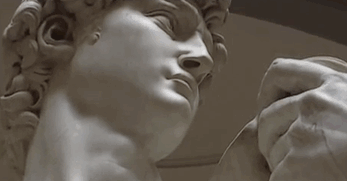
SCULPTING THE PERFECT MAN
Believe it or not, the sculpted physique that is idealized for males in modern Western society parallels the Hellenistic sculptures from Ancient Europe. While body ideals for women constantly fluctuate with the time, the body ideals for men have remained quite concrete since the Hellenistic era. Whether chilling in the bath houses or changing for football practice, fam's gotta be ripped.

Laocoon and His Sons
It is evident that there have been distinct shifts within Greek artwork, specifically sculpture, reflected through the societal progression in Ancient Greece.



Statue of David

The Dipylon Kouros
The Strangford Apollo of Anafi

Archaic
(650-500 BCE)
The first Greek sculptures mimc the style of artwork from Egypt. Inspired by the Egyptian tombs at the time, Greek artists created free-standing statues. These statues are characterized by their frontal view, broad shoulders, and upright posture. Even in times of despair or pain, Also, Archaic Greek statues were always shown smiling. It was thought that if the statue showed expression in the face, like with a smile, then it would be assumed that the depicted person was alive.
Famous examples from this time period include The Dipylon Kouros (created circa 600 BCE) and The Strangford Apollo of Anafi (created circa 600-580 BCE).

Doryphorus
Classical
(500-323 BCE)
As Greek sculptors became more skilled and interested in depicting the human body, and began deviating from the rigid postures characterized by Archaic sculpture, the Classical era was established.
The focus of this time period was to find a way to better represent the anatomy of the body. Archaic sculptures did not have fine details like the sculptures of the Classical period had. More malleable mediums like bronze made it easier to define the silhouette of the body. It is apparent that there is more definition of the ribs, abdominal muscles, and facial structures than in Archaic sculptures.
Famous Classical pieces include the Riace Bronze A (created circa 450 BCE), as well as Doryphorus (created circa 440).

Riace Bronze A
Greek sculptors grew tired of portraying male bodies accurately. The Greeks had perfected their craft of sculpting the body's proportions. Reaching beyond reality, the hypermasculine ideals still present today were born in the Hellenistic era.
Sculptures from this time frame exhibit unnatural tone. For instance, the story of Loacoon fighting the serpents sent from the gods is brought to life in the statue Loacoon and His Sons. Loacoon's build can be described as almost heroic; the tension in the biceps, triceps, lats, and quads emphasizes the struggle that fighting the serpents was.
Hellenistic
(323-27 BCE)

Laocoon and His Sons
Borghese Gladiator






Statue of David
Referring to famous sculptures like Borghese Gladiator (created circa 100 BCE), it is apparent that many Hellenistic sculptures have enhanced the chest and shoulders in size and muscularity. The genitals and waist, however, were often reduced in size. Another feature common to this era was the embellishment of the Adonis belt/pelvic V.
A famous Italian sculpture (said to have been inspired by Ancient Greek sculpture) that is often reflected as the ideal male body has this very feature. This statue, known as David, has the Adonis belt stretching beyond the anterior pelvis into the back; anatomically speaking, this is not possible to attain, as this muscle does not extend into the back.
Parallels Today
Much of Ancient Greek art reflects the Greek culture of that time. Your body was a reflection of your commitment to the gods. By having a more fit frame, you were thought to be more favored by the gods. Although it is difficult to speak for people of this time period (the Hellenistic era, that is), experts believe that this desire to sculpt the perfect body was not a reflection of body dissatisfaction or narcissism but rather a representation of one's spirituality. Even the Olympic games originated with the intent of showcasing the athletes' spiritual commitment.
These ideals of muscularity have miraculously held since Ancient Greek times. The idea that unfit or deformed bodies were not ideal was expressed through Greek mythology. Hephaestus, for instance, was a Greek god who was thrown off of Mount Olympus because of his appearance. He was lame according to the myths and his mother, Hera, therefore did not think he was worthy of living on Mount Olympus. If this was not enough to indirectly say, "being different is shameful and unattractive", Hephaestus's experience with his wife will surely convince you. Hephaestus was married to the goddess of beauty, Aphrodite. Aphrodite blatantly had affairs with other men, sometimes even in front of Hephaestus. So, this association between shame and an unfit body subconsciously wove into European society and has remained until today.
Just as if these Greek myths hold true today in the western culture, being different or disabled is still frowned upon. If men have been bombarded with these messages since before the turn of the Common Era, it is evident how deeply rooted this issue is in our culture.
The Body Beautiful - Ancient Greeks Documentary